Olympian Gods and Goddesses
In this section, you will find fourteen Olympian Gods and Goddesses. There are a quick descriptions and pictures of the Gods or Goddesses. In the brief description, you can find what kind of God or Goddess they are, there siblings or parents, an important part of their life. You will also learn about their symbols, and some of their Egyptian similarities.
Zeus (God of thunder and ruler of the gods)
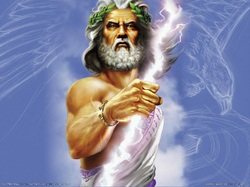
Boom! Crackle! The powerful thunder hovers over the entire world. This is the true power of Zeus, the "Ruler of all Gods/Men and god of thunder". Zeus was the child of Cronus and Rhea, being the youngest of his siblings. He served great importance to Greek mythology, such as the creation of mankind. His signature weapon was a thunder bolt, representing his control over lightning. His Egyptian similarity are either Ra, Seth, or Nut, due to the fact that they all rule elements of the sky.
Poseidon (God of the sea and of earthquakes)
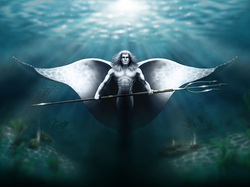
From over seventy percent of earth's surface being water, there must be a ruler fit to conquer all of the sea. In that case, Poseidon is as such. His brothers were Zeus and Hades, with Poseidon being the middle brother. Poseidon contained remarkable powers of signal sea creatures using sonar waves, and he could create enormous waves strong enough to wipe out a whole civilization. Poseidon's signature weapon is a trident, a spear with three blades.
Hades (God of the underworld and of the dead)
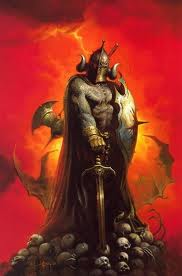
Where the dead goes, Hades comes. Hades was the god of the underworld and of the dead. He is the oldest male child of Cronus and Rhea, being older then his two brothers Zeus and Poseidon. According to Greek myth, he and his brothers defeated the Titans and demanded full ownership over the cosmos: the underworld, the sea, and the sky. Because of his demonic icon, he was often interpreted as the personification of the underworld and of the dead itself. His main symbol features the Helm of Darkness and his three headed dog, Cerberus. His Egyptian similarity is Osiris, both representing the underworld and the dead.
Hephaestus (God of fire and metalwork)
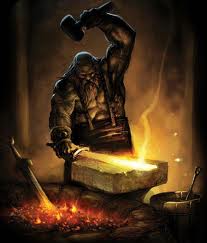
Hephaestus is a powerful Olympian god known for his mastery over fire and breath-taking craftsmanship. He forged millions of weapons, armor, and other iron goods. In Greek script, Hephaestus even built Zeus's thunder bolt and Athena's armor. However, despite his beautiful works, he was cursed by the Titans, who burnt his face and was given a hideous appearance. He was overly-bulk; with grotesque appearance and terrible odor. He was considered lame; although he was a major counterpart to the god's armory. His Egyptian similarity is Amun, for they both create items and substances.
Hermes (Messenger of the gods)
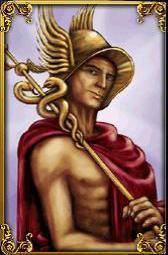
Back in the olden days, there were no emails, phones, or other communicational devices. Although the Olympian gods possessed great power and infinite abilities, Hermes was there. Hermes was the messenger of the gods, being known to deliver the messages to the gods. With his incredible speed and agility, he was able to send those letters in a blink of an eye. His symbols are winged shoes, a winged hat, and a golden snake-designed staff.
Ares (God of war)
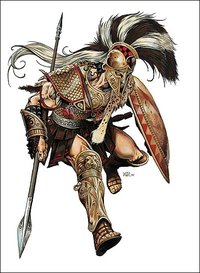
Clash! Bang! These are the sounds of warfare; arrows flying, swords clashing, and shields bashing. When there was war, there was Ares. Ares was the Olympian god of war. He was the son of Zeus and Hera. His figure often represents physical violence and the aspects of war. He contrasts to Athena, who focuses on military tactics and war intelligence over brute combat. He was believed to be immortal, even through the bloodiest of conflicts. He was known to be the lover of Aphrodite (who was married to Hephaestus), despite the fact that their parents forbid their love. Ares's symbols are an iron spear, blood-stained helmet, a dog, a royal chariot, and a boar. His Egyptian similarity is Set, both resembling chaos and violence.
Apollo (God of light, truth, and healing)
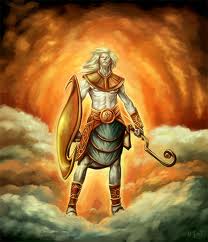
Doctors and medical workers could fall under Apollo's work in Greek mythology. Apollo is the Olympian god of light, truth, and healing. According to Greek manuscripts, Apollo was so pure of heart and enlightened that it was impossible to look at him (because he resembles the sun). Apollo was the son of Zeus and Leto, as his sister was Artemis. His symbols are a lyre, a laurel wreath, a python, and bows/arrows. His Egyptian similarities are either the sun god Ra or Ma'at, god of justice.
Dionysus (God of wine and fertility)
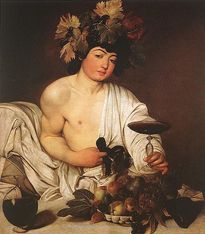
Dionysus was the god of wine and grape harvest. Born from Zeus and Semele, Dionysus spent most of his life harvesting grapes and turning it into refreshing wine. Some considered his wine to be so delicious that they considered it a piece of incredible art (some say that it rivals Hephaestus's iron works). He also invented a series of rituals known as the Dionysian Mysteries, such as dance and music, to captivate anybody's mind.
Hera (Wife of Zeus and queen of the gods)
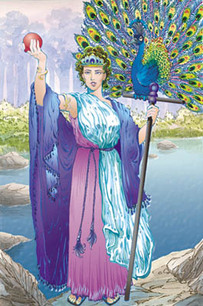
Hera was Zeus' wife and the goddess of all gods. She was very pretty, in which she was given Zeus as a husband. Despite her marvelous beauty, she was nicknamed "Cow-faced" (or in some cases "Ox-eyed") for having a large thirst of beauty. Some say that Hera was the creator of Paris, due to the fact that Paris symbolizes much loveliness. Her respective symbols are a pomegranate (for symbolizing life) and peacock feathers. Her Egyptian similarity is Isis, due to the fact that they are both queens of the gods.
Athena (Goddess of wisdom and war)
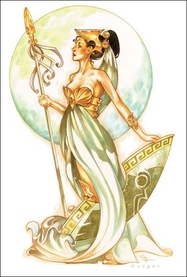
Athena was the god of wisdom and war. Athena was born from Zeus's split skull after he ate his mother Metis. She was a Titan, however, and she had not been killed as she continued to have Athena in her womb and soon gave birth to a strong baby. Zeus complained about headaches and had Hephaestus cut his head open to remove the nuisance. Athena flew out of the broken skull of Zeus. Her animal was an owl to symbolize wisdom. Her other symbol was a Spartan helmet and spear to show her undying bravery and dedication to war. Her Egyptian similarity could be Thoth, for they both show wisdom.
Artemis (Goddess of the moon and of hunting)
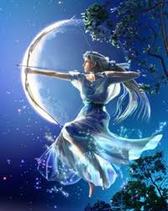
The glorious moon is showing its beauty across the world. A sleek hunter slowly limped to his target. He aims his weapon and presses its trigger. Artemis was there. She was the goddess of the hunt. she was enjoyed moonlight, and her bow curved to show the shape of a crescent moon. She was known as to control women and gave them bravery to strive to their goals. She could bring a helping hand and give children to the women. Her Roman name is Diana. Her symbols are bows/arrows, stags, hunting dogs, and the moon.
Demeter (Goddess of agriculture)
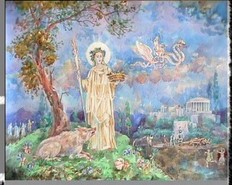
Demeter was the god of agriculture. She was in charge of fertility in the earth. She was also in control of the four seasons. Though Demeter is often described simply as the goddess of the harvest, she ruled over the sanctity of marriage, the sacred law, and the cycle of life and death. Demeter, as an agricultural goddess, appears rarely in the poetry piece Odyssey (which was written by the famous poet Homer). She was a blond-haired goddess who separated the chaff from the grain. Her symbols are a torch, a lion, and sheaves of wheat.
Aphrodite (Goddess of love)
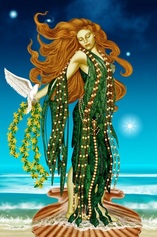
Aphrodite was the god of love. They say she was born from the sea, when Uranus was killed. From his body a girl grew and was named Aphodite. Then she was carried ashore by the waves in a scallop shell. As she grew up, she claims no memory about her childhood. When she emerged from a sea shell, she was a full grown woman, beautiful and full of grace. Because of her beauty, other gods feared that jealousy over Aphrodite would disrupt peace and unity, and so Zeus married her to Hephaestus, who posed no threat among the Olympian gods. Her symbols were a dolphin, a rose, scallop shells, a dove, and a mirror. Her Egyptian similarity is Hathor, for they both represent love.
Hestia (God of the hearth)
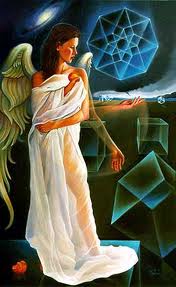
Hestia was the first daughter of Cronus and Rhea. She was the goddess of hearth, architecture, and domesticity of the family. Hestia was one of the the three great goddesses of the first Olympian generation, along with Demeter and Hera. She was known to be the younger sister of Zeus, Poseidon, and Hades. She prayed on hearths and other gems in order to bring balance for Mount Olympia (and the Cosmos). Her heart was so pure and strong that those hearth stones glowed as she touched them. Her symbols are hearths, kettles, candles, brooms, crane, pig, and donkey.
